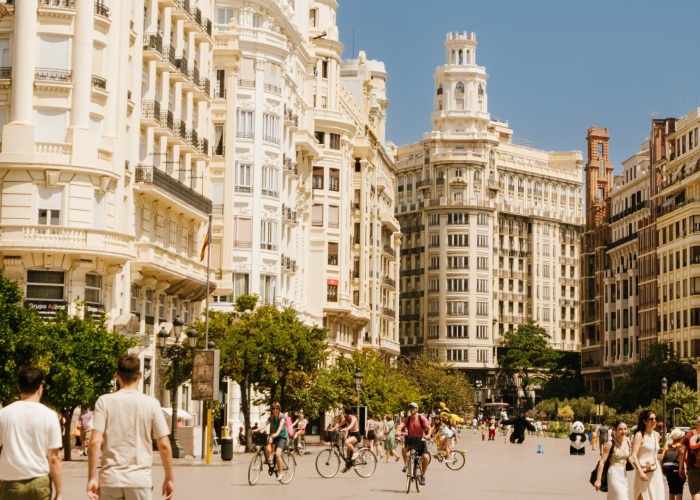Valencia is not just a place to relax or have fun… it’s a city where art and culture are part of everyday life!
Moving to Valencia is not just about choosing a pleasant place to live: it also means enjoying a city where culture plays a central role. With its historical monuments, museums and countless artistic events, Valencia offers a lively lifestyle open to all tastes.
The charm of the city lies in its blend of heritage and modernity.
The historic centre, with its narrow streets, Gothic buildings and baroque façades, tells the story of Valencia centuries ago. But just a few steps away, the futuristic architecture of the City of Arts and Sciences perfectly illustrates Valencia’s contemporary energy and its drive for innovation. This coexistence between old and new gives the city a unique identity, where every neighbourhood tells a different story.
Culture is lived daily. Locals regularly enjoy temporary exhibitions, open-air festivals and concerts in public squares. Art isn’t limited to institutions: it’s also found in the streets, through the colourful murals of the El Carmen district, a true open-air museum.
Art galleries, often located in renovated historic buildings, help fuel this cultural dynamism that attracts both local residents and visitors.
Valencia is a walkable, human-sized city where it’s easy to explore new cultural spaces. Museums, theatres and exhibition venues are accessible, nearby cafés and markets offer moments of conviviality, and the overall atmosphere encourages curiosity. Whether you love classical art, contemporary creation or simply a lively urban lifestyle, Valencia has something for everyone.
Living in Valencia means enjoying a city where culture is part of everyday life — a place that values its past while looking toward the future.

Valencia is much more than a sunny city where life is pleasant: it is a true crossroads between tradition and modernity, where art and culture can be found on every street corner.
1. An iconic museum heritage
Valencia showcases its history through museums and exhibitions such as:
The Museo de Bellas Artes de València (Museum of Fine Arts), one of the city’s major museums, featuring collections from the 15th to 19th centuries, including works by Diego Velázquez, Francisco Goya, and more.
With more than 60 cultural spaces — museums, monuments, multidisciplinary art centres — Valencia clearly shows its ambition to make culture a key element of the city.
A few museums:
IVAM – Institut Valencià d’Art Modern, dedicated to modern and contemporary art, with internationally renowned collections.
Fundación Bancaja, offering temporary exhibitions and works by Picasso and Sorolla.
Museo Nacional de Cerámica y Artes Suntuarias González Martí (Palacio del Marqués de Dos Aguas), dedicated to Valencian ceramics and decorative arts.
2. Art galleries, contemporary creation and street art
Beyond historical museums, Valencia also stands out for its strong contemporary energy. Art galleries and cultural centres in dynamic districts offer new experiences:
Centre del Carme Cultura Contemporània (CCCC), located in El Carmen in a former royal monastery, combining installations, design, graffiti and emerging artists.
Hortensia Herrero Art Center, hosted in a magnificent 17th-century palace, featuring a major private collection and international contemporary artworks.
In the streets, urban art is also very present: the El Carmen district has become an open-air art gallery, where street art meets historical architecture.
These spaces show that Valencia doesn’t just preserve its heritage — it reinvents itself with creativity and openness.
3. Architecture, iconic places and public culture
Valencia’s cultural life goes far beyond museums and galleries: it also thrives in public spaces, spectacular buildings and gathering places.
The City of Arts and Sciences is emblematic: futuristic architecture, interactive museums (like the Museu de les Ciències Príncipe Felipe) and sculpture gardens.
L’Umbracle, part of the same complex, is an open-air sculpture garden with contemporary works set among lush vegetation — a beautiful blend of nature, art and architecture.
Every neighbourhood, square and façade can become a cultural stage, making the city constantly alive for locals and visitors alike.
4. Major events in Valencia
Valencia is lively all year long, with a full calendar of festivities and cultural happenings. Its most iconic event is Las Fallas, in March, when the city lights up with fireworks and giant sculptures that are burned during the cremà.
The city also hosts many music, art and food festivals, such as the Big Sound Festival, exhibitions at the City of Arts and Sciences, or the Ruta Gastronómica Cacaus d’Or. Between tradition, culture and modern shows, Valencia attracts thousands of visitors every year.
5. Who is it for? Why live here?
Choosing to live in Valencia means choosing a stimulating cultural environment. A few reasons why:
Easy access to high-quality museums, often with affordable prices or free entry days.
A wide range of artistic styles: from classical to contemporary art, including street art and cutting-edge architecture.
Vibrant neighbourhood life, with cafés, galleries and cultural events nearby.
Every weekend, multiple events across all fields!
Conclusion
Valencia is a city that breathes art: in its museums, in its galleries, in its bright and creative streets. Blending culture, history and innovation, Valencia offers a unique living environment that inspires and enriches daily life.
